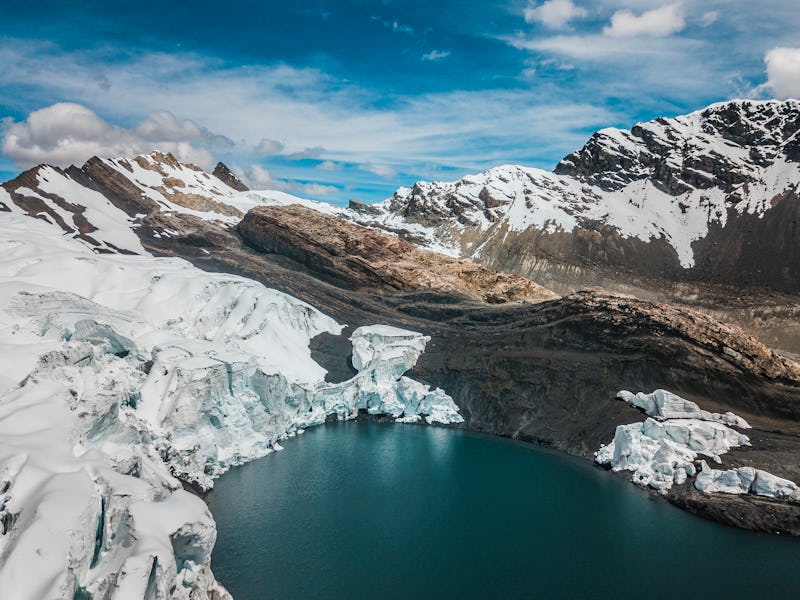Melting Glaciers Are Having an Unexpectedly Positive Effect on Carbon Dioxide
But don't expect it to be a climate change savior.

Our planet’s glaciers are melting at all three poles, offering indisputable evidence of the global climate crisis. But even as these ancient masses of ice shrink away, they may perform one final beneficial, if minor, act for the Earth. Glacial meltwaters are rich in dissolved minerals, and research in PNAS on Monday suggests that these minerals could lead to the absorption of a lot of carbon dioxide from Earth’s atmosphere.
In the paper, researchers show that the watershed of Canada’s Lake Hazen, which is fed by several glaciers, consumes CO^^2 as far as 26 miles downstream. This finding could change the way scientists think about how freshwater ecosystems will respond to a warming planet, forcing us to reevaluate the way that melting glaciers will contribute to climate change, at least in the near future.
Kyra Saint Pierre, Ph.D., a postdoctoral fellow at the University of British Columbia and the paper’s first author, tells Inverse that we shouldn’t expect this process to be a last-minute climate change savior, though.
“I think that the potential to mistakenly perceive this as a ‘good news story’ in the era of the climate emergency is high, but it’s important to remember that glaciers are a finite resource,” she says. And since her team only showed that glacial meltwater can capture CO^^2 in a relatively short period of time, St. Pierre warns against making too many assumptions about how this dynamic will play out over many years.
The researchers examined the watershed of Lake Hazen, an Arctic lake in Canada that's fed by several glaciers.
Most freshwater bodies are significant CO^^2 producers and are expected to get worse as the planet heats up. But St. Pierre and her team found that glacial meltwaters seem to be exceptions to this rule. Whereas most freshwater sources contain decaying organic matter like leaf litter and dead animals that release carbon dioxide as they decompose, glacial waters are different. This new research indicates that dissolved inorganic carbon and silica in glacial meltwater actually consumes CO^^2 from the atmosphere through a process known as weathering reactions.
This may sound like good news on its surface, but as she pointed out, it’s likely just a small speedbump in the road if global communities and industries don’t curb CO^^2 emissions.
And in fact, St. Pierre says it’s very likely that glacial waters will only be able to keep up the CO^^2 absorption act for a limited amount of time.
The mineral composition of glacial meltwaters make them excellent absorbers of carbon dioxide, but they probably won't balance out climate change.
“Because the ability of glacial meltwaters to consume CO^^2 scales with the amount of glacial meltwater (i.e., the more CO^^2 is consumed, the more meltwater there is and vice versa), this property is only relevant as long as there are glaciers and substantial volumes of meltwater,” she says.
She points out that in warmer parts of the world, glaciers have already passed their so-called peak water, “the point after which the volume of meltwater declines until the glacier is lost.”
“In the Arctic, ‘peak water’ is projected to occur towards the end of this century, depending on the region” St. Pierre adds.
“But in any case, we’re essentially only talking about a short term process without a dramatic reversal of the current climate warming.”
Abstract:
Carbon dioxide (CO^^2) emissions from freshwater ecosystems are almost universally predicted to increase with climate warming. Glacier-fed rivers and lakes, however, differ critically from those in nonglacierized catchments in that they receive little terrestrial input of organic matter for decomposition and CO^^2 production, and transport large quantities of easily mobilized comminuted sediments available for carbonate and silicate weathering reactions that can consume atmospheric CO^^2. We used a whole-watershed approach, integrating concepts from glaciology and limnology, to conclusively show that certain glacier-fed freshwater ecosystems are important and previously overlooked annual CO^^2 sinks due to the overwhelming influence of these weathering reactions. Using the glacierized Lake Hazen watershed (Nunavut, Canada, 82°N) as a model system, we found that weathering reactions in the glacial rivers actively consumed CO^^2 up to 42 km downstream of glaciers, and cumulatively transformed the High Arctic’s most voluminous lake into an important CO^^2 sink. In conjunction with data collected at other proglacial freshwater sites in Greenland and the Canadian Rockies, we suggest that CO^^2 consumption in proglacial freshwaters due to glacial melt-enhanced weathering is likely a globally relevant phenomenon, with potentially important implications for regional annual carbon budgets in glacierized watersheds.